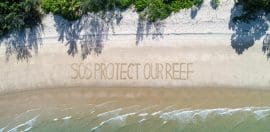Shining a light on the cleanest (and dirtiest) power

8 February 2022 at 7:30 am
Greenpeace’s Green Electricity Guide is designed to enable every Australian to quickly select a cleaner electricity provider. But its real power, says David Ritter, is to put pressure on the worst climate polluters who feature in the bottom of the rankings.
The wheels of change are turning very fast indeed in Australia’s electricity sector. The AEMO now predicts the end of coal will come at least three times faster than expected. This will need to be even swifter still, if Australia is to meet the 2030 deadline for coal closures in line with the internationally agreed Paris climate goals. We’ve gained great pace – but we need to be moving at emergency speed.
This is the sectoral context in which the third iteration of Greenpeace’s Green Electricity Guide (previously produced in collaboration with our good mates at the Total Environment Centre of NSW) is released today. The Guide (GREG as it is affectionately known to the project team who have been responsible for the research and analysis) is Australia’s only comprehensive and independent guide to the clean energy credentials of Australia’s retail electricity providers.
The Green Electricity Guide is an easy tool designed to enable every Australian to quickly select a cleaner electricity provider and is meeting a clear demand in the community. Personally, I’m delighted that GREG is out in the world today, because one of the questions I’m asked most often by family, friends and acquaintances is where to go for the cleanest power? People want to do the right thing, and there is a hunger for the answer – so I will be sharing the link widely today!
GREG is designed to be helpful for consumers, but the real power of the guide is structural and systemic – mounting further pressure against some of Australia’s worst climate polluters who feature in the bottom of the rankings. Demand for coal is already falling away, and as the AFR reported this week “fossil fuel power generators are struggling to compete against soaring renewable energy generation”.
GREG should be of keen interest to company directors, too. The duty of care and diligence imposed upon company directors by section 180(1) of the Corporations Act 2001 (Cth) permits, and in many cases requires, Australian company directors to respond to the risks and opportunities posed by climate change. The Australian Institute of Company Directors’ Climate Risk Governance Guide launched last year is a helpful resource to all directors in this context.
Australia’s biggest energy company, and Australia’s biggest climate polluter – AGL – has been ranked dead last. This will come as a surprise to some, because it was not that many years ago that AGL looked like it was ahead of the game, pursuing the business-savvy path of proactive adoption of renewables under the leadership of then CEO Andy Vesey. However, since Vesey’s politically influenced departure, AGL has doubled-down on coal – and effectively lost the plot, losing billions of dollars in shareholder value in the process. Instead of substantive transition, AGL has preferred to invest in greenwashing communications campaigns.
As AGL chairman Peter Botten openly acknowledged, AGL’s board undeniably failed to anticipate change in the strategic environment of the business:
“Look I suppose there is no doubt that the winds have changed and the electricity market has been substantially faster than many people had anticipated, certainly from my perspective those winds have been extremely fast. I certainly didn’t see quite the level of change and the acceleration of that change here in my thinking 12 months ago and I believe that would be representative of the AGL board.”
The truth is that 83 per cent of AGL’s generation comes from burning coal and they plan to continue mining and burning coal until 2048. This means the wooden spoon is well-deserved.
For a troubled dinosaur company like AGL – responsible for 8 per cent of domestic climate emissions because of its coal mining and burning, and whose leadership openly admits to a failure to effectively anticipate industry trends in the sector – the only viable future is a decisive turn to becoming a 100 per cent renewable energy provider.
On the other hand, congratulations to Enova Energy and Diamond Energy who feature at the top of the rankings. And let’s give a shout-out to every single person out there who is working their hardest to deliver Australia’s clean electricity transformation – sincerely, thank you.
Sadly, Powershop, once seen as an icon of cleaner electricity, has now tumbled down the rankings by virtue of its corporate take-over by the multinational fossil fuel behemoth, Shell.
Greenpeace’s independence is particularly important in a context like GREG. Greenpeace accepts no funding from any government or business in Australia, or anywhere in the world. I am sometimes asked why our self-imposed ban on accepting funding from business even includes sectors that are aligned with our goals – such as a renewable electricity provider. “Greenpeace supports a rapid transition from fossil fuels to renewable energy – so surely you could accept a donation from a solar company for example?” The answer is that our financial independence is a non-negotiable core value for Greenpeace, which means that work like rating electricity providers can be done without any hint of fear or favor brought about by sponsorship arrangements.








How does this deal with the situation in the ACT were the Government is driving purchase of renewable energy?